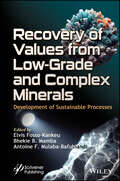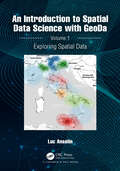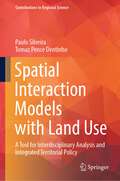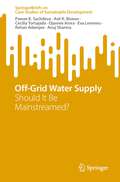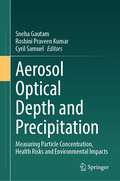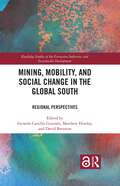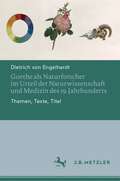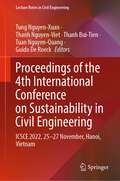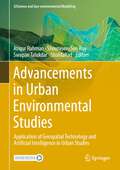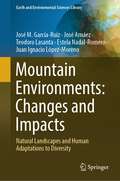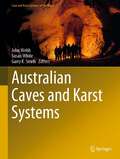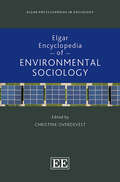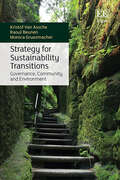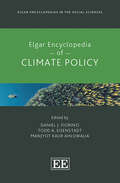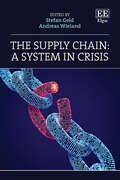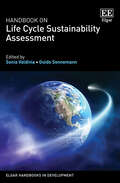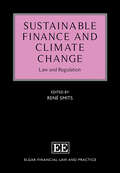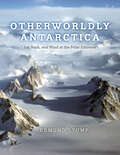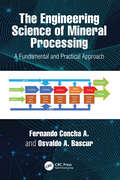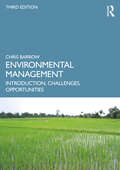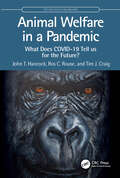- Table View
- List View
Recovery of Values from Low-Grade and Complex Minerals: Development of Sustainable Processes
by Elvis Fosso-Kankeu Bhekie B. Mamba Antoine F. Mulaba-BafubiandiRecovery of Values from Low-Grade and Complex Minerals The book elaborates on various physicochemical properties of minerals and technological developments to improve the recovery of metals while ensuring cost-effectiveness and minimal environmental impact. The mineral industry is undergoing significant cultural, organizational, and technological transformations to address some of the major limitations and challenges related to the environmental and productivity domains. As far as productivity is concerned, the decrease of high-grade ores has been one of the stumbling blocks toward the achievement of maximum recovery of metals while, on the other hand, the complexity of minerals therein makes it difficult to profitably extract metals using only conventional methods. This book presents eight specialized chapters that focus on the exploration of the complexity of minerals that are likely to negatively influence the recovery of values, as well as the development of adequate technologies capable of improving the process of mineral concentration and/or metal recovery from complex minerals in a sustainable manner. It reviews the various physicochemical properties of minerals that are likely to pose a challenge during the attempt to recover values using conventional methods. It also elaborates on the recent technological development that has been considered by researchers to improve the recovery of metals from gangue-dominated minerals while ensuring cost-effectiveness and minimal adverse environmental impact. Audience This book will be of interest to academic researchers from the fields of mineral processing, hydrometallurgy, geochemistry, environment, chemistry, engineering, and professionals including mining plant operators, environmental managers in the industries, government regulatory bodies officers, and environmentalists.
An Introduction to Spatial Data Science with GeoDa: Volume 1: Exploring Spatial Data
by Luc AnselinThis book is the first in a two-volume series that introduces the field of spatial data science. It offers an accessible overview of the methodology of exploratory spatial data analysis. It also constitutes the definitive user’s guide for the widely adopted GeoDa open-source software for spatial analysis. Leveraging a large number of real-world empirical illustrations, readers will gain an understanding of the main concepts and techniques, using dynamic graphics for thematic mapping, statistical graphing, and, most centrally, the analysis of spatial autocorrelation. Key to this analysis is the concept of local indicators of spatial association, pioneered by the author and recently extended to the analysis of multivariate data.The focus of the book is on intuitive methods to discover interesting patterns in spatial data. It offers a progression from basic data manipulation through description and exploration to the identification of clusters and outliers by means of local spatial autocorrelation analysis. A distinctive approach is to spatialize intrinsically non-spatial methods by means of linking and brushing with a range of map representations, including several that are unique to the GeoDa software. The book also represents the most in-depth treatment of local spatial autocorrelation and its visualization and interpretation by means of GeoDa.The book is intended for readers interested in going beyond simple mapping of geographical data to gain insight into interesting patterns. Some basic familiarity with statistical concepts is assumed, but no previous knowledge of GIS or mapping is required.Key Features:• Includes spatial perspectives on cluster analysis• Focuses on exploring spatial data• Supplemented by extensive support with sample data sets and examples on the GeoDaCenter websiteThis book is both useful as a reference for the software and as a text for students and researchers of spatial data science.Luc Anselin is the Founding Director of the Center for Spatial Data Science at the University of Chicago, where he is also the Stein-Freiler Distinguished Service Professor of Sociology and the College, as well as a member of the Committee on Data Science. He is the creator of the GeoDa software and an active contributor to the PySAL Python open-source software library for spatial analysis. He has written widely on topics dealing with the methodology of spatial data analysis, including his classic 1988 text on Spatial Econometrics. His work has been recognized by many awards, such as his election to the U.S. National Academy of Science and the American Academy of Arts and Science.
An Introduction to Spatial Data Science with GeoDa: Volume 1: Exploring Spatial Data
by Luc AnselinThis book is the first in a two-volume series that introduces the field of spatial data science. It offers an accessible overview of the methodology of exploratory spatial data analysis. It also constitutes the definitive user’s guide for the widely adopted GeoDa open-source software for spatial analysis. Leveraging a large number of real-world empirical illustrations, readers will gain an understanding of the main concepts and techniques, using dynamic graphics for thematic mapping, statistical graphing, and, most centrally, the analysis of spatial autocorrelation. Key to this analysis is the concept of local indicators of spatial association, pioneered by the author and recently extended to the analysis of multivariate data.The focus of the book is on intuitive methods to discover interesting patterns in spatial data. It offers a progression from basic data manipulation through description and exploration to the identification of clusters and outliers by means of local spatial autocorrelation analysis. A distinctive approach is to spatialize intrinsically non-spatial methods by means of linking and brushing with a range of map representations, including several that are unique to the GeoDa software. The book also represents the most in-depth treatment of local spatial autocorrelation and its visualization and interpretation by means of GeoDa.The book is intended for readers interested in going beyond simple mapping of geographical data to gain insight into interesting patterns. Some basic familiarity with statistical concepts is assumed, but no previous knowledge of GIS or mapping is required.Key Features:• Includes spatial perspectives on cluster analysis• Focuses on exploring spatial data• Supplemented by extensive support with sample data sets and examples on the GeoDaCenter websiteThis book is both useful as a reference for the software and as a text for students and researchers of spatial data science.Luc Anselin is the Founding Director of the Center for Spatial Data Science at the University of Chicago, where he is also the Stein-Freiler Distinguished Service Professor of Sociology and the College, as well as a member of the Committee on Data Science. He is the creator of the GeoDa software and an active contributor to the PySAL Python open-source software library for spatial analysis. He has written widely on topics dealing with the methodology of spatial data analysis, including his classic 1988 text on Spatial Econometrics. His work has been recognized by many awards, such as his election to the U.S. National Academy of Science and the American Academy of Arts and Science.
Spatial Interaction Models with Land Use: A Tool for Interdisciplinary Analysis and Integrated Territorial Policy (Contributions to Regional Science)
by Paulo Silveira Tomaz Ponce DentinhoThis book develops spatial interaction models for the analysis of human interaction within space, in terms of both accessibility and land use. Presenting case studies on the Azores and Morocco, it covers applications in various regions of Europe and Africa. The respective models simulate land use, employment, households, commuting and shopping movements and land values, employment distribution for basic activities, changes in accessibility, and changes in land suitability due to climate change.This book will appeal to scholars and students of regional and spatial science, ecological economics, and agricultural economics, as well as to spatial planners and practitioners dealing with issues of spatial planning to address such problems as unsustainable land use, adaptation to climate change, desertification of rural areas heavily dependent on land use, and the impacts of external shocks on land and property values.
Off-Grid Water Supply: Should It Be Mainstreamed? (SpringerBriefs on Case Studies of Sustainable Development)
by Pawan K. Sachdeva Asit K. Biswas Cecilia Tortajada Ojasvee Arora Eva Leneveu Rehan Adamjee Anuj SharmaThis book highlights unique and deeper insights into the operations of off-grid water supply business models and the policy implications that they raise. The two key research questions of the report are as follows: 1) What is the efficacy and sustainability of the off-grid model of safe water availability and/or delivery to consumers who don’t have piped water supply? 2) What are the key policy considerations for planning a successful off-grid model of safe water delivery? Through the Four-Domain Framework, this book does the gap analysis of the physical, operational, financial, and institutional domains of the few off-grid water operators in cross-country case studies. It also includes a detailed financial analysis of the capital costs as well as operations and maintenance costs of the different off-grid water supply models compared to some of the piped water supply models. The final discusses the need to acknowledge off-grid water solutions in urban water policies, especially for the economically weaker sections. The universal coverage of all by the piped water is an ultimate goal of any water policy; however, in the interim, there is a need to put more emphasis on off-grid water solutions.
Aerosol Optical Depth and Precipitation: Measuring Particle Concentration, Health Risks and Environmental Impacts
by Sneha Gautam Cyril Samuel Roshini Praveen KumarThis volume uses aerosol optical depth (AOD) analysis through mapping and remote sensing techniques to derive the relationship between aerosols and hazardous precipitation events, primarily in the form of flooding. Attention is also given to pollution caused by an abundance of particulate matter in the atmosphere and its impacts on human health, which is also assessed via the study of AOD. Background is given on how AOD is retrieved, and why it is a useful tool for estimating atmospheric particle concentration, but also the challenges associated with using this approach. Different aerosol types are introduced to perform a comparative analysis of the most common associations between pollution impacts on temperature and resulting precipitation events. These analyses will help to provide an overview of the best strategies to make informed and sustainable disaster risk management practices and policies. The target audience for the work is students, researchers, and scientists working witha vision towards sustainability, public health safety and air pollution mitigation measures. It will also be a useful text for climate change policy makers, environmental engineers and stakeholders in social development sectors.
Mining, Mobility, and Social Change in the Global South: Regional Perspectives (Routledge Studies of the Extractive Industries and Sustainable Development)
by Gerardo Castillo Guzmán Matthew Himley David BreretonThis volume focuses on how, why, under what conditions, and with what effects people move across space in relation to mining, asking how a focus on spatial mobility can aid scholars and policymakers in understanding the complex relation between mining and social change. This collection centers the concept of mobility to address the diversity of mining-related population movements as well as the agency of people engaged in these movements. This volume opens by introducing both the historical context and conceptual tools for analyzing the mining-mobility nexus, followed by case study chapters focusing on three regions with significant histories of mineral extraction and where mining currently plays an important role in socio-economic life: the Andes, Central and West Africa, and Melanesia. Written by authors with expertise in diverse fields, including anthropology, development studies, geography, and history, case study chapters address areas of both large- and smallscale mining. They explore the historical-geographical factors shaping mining-related mobilities, the meanings people attach to these movements, and the relations between people’s mobility practices and the flows of other things put in motion by mining, including capital, ideas, technologies, and toxic contamination. The result is an important volume that provides fresh insights into the social geographies and spatial politics of extraction. This book will be of great interest to students and scholars of mining and the extractive industries, spatial politics and geography, mobility and migration, development, and the social and environmental dimensions of natural resources more generally.
Goethe als Naturforscher im Urteil der Naturwissenschaft und Medizin des 19. Jahrhunderts: Themen, Texte, Titel
by Dietrich von EngelhardtGoethe als Naturforscher findet bei deutschen und ausländischen Naturforschern und Medizinern des 19. Jahrhunderts durchgängig Beachtung und führt zu einer Fülle spezifischer Goethe in dieser Hinsicht gewidmeten Studien mit Interpretationen und Beurteilungen – neben wiederholt vorkommenden knapperen Ausführungen oder kurzen Hinweisen in naturwissenschaftlichen und medizinischen Publikationen der Zeit. Übergreifende Veröffentlichungen über Goethe und die Romantik, über seine Stellung in Europa, über seine Beziehungen zu England, Frankreich, Italien, Spanien, den skandinavischen und slavischen Ländern behandeln meist nur seine literarischen und geisteswissenschaftlichen Werke und gehen allenfalls begrenzt auf seine naturwissenschaftlichen Beiträge und ihre Aufnahme in den Naturwissenschaften und Medizin ein. Diese fachspezifische Zurückhaltung gilt auch für Bibliographien der Übersetzungen deutscher Veröffentlichungen des 19. Jahrhunderts in europäische Sprachen; naturwissenschaftliche und medizinische Publikationen kommen in ihnen nicht oder nur sporadisch vor. Der vorliegende Band schließt diese Lücke. Neben einer umfassenden Bibliographie von 260 Titeln von Naturwissenschaftlern und Medizinern über Goethe als Naturforscher steht eine Wiedergabe von 48 entsprechenden nicht nur deutschen, sondern vor allem auch internationalen und oft an entlegenen Orten erschienenen Arbeiten.
Proceedings of the 4th International Conference on Sustainability in Civil Engineering: ICSCE 2022, 25-27 November, Hanoi, Vietnam (Lecture Notes in Civil Engineering #344)
by Tung Nguyen-Xuan Thanh Nguyen-Viet Thanh Bui-Tien Tuan Nguyen-Quang Guido De RoeckThis book contains the proceedings of the 4th International Conference on Sustainability in Civil Engineering, ICSCE 2022, held on November 25–27, 2022, in Hanoi, Vietnam. It presents the expertise of scientists and engineers in academia and industry in the field of bridge and highway engineering, construction materials, environmental engineering, engineering in Industry 4.0, geotechnical engineering, structural damage detection and health monitoring, structural engineering, geographic information system engineering, traffic, transportation and logistics engineering, and water resources, estuary, and coastal engineering.
Advancements in Urban Environmental Studies: Application of Geospatial Technology and Artificial Intelligence in Urban Studies (GIScience and Geo-environmental Modelling)
by Atiqur Rahman Shouraseni Sen Roy Swapan Talukdar ShahfahadAccording to UN estimates, approximately nearly half of the world's population now lives in cities and that figure is expected to rise to almost 70% by 2050. Cities now account for around 70% of worldwide greenhouse gas emissions, and this percentage is predicted to rise in the near future as a result of projected increases in global urbanization patterns. It is widely acknowledged that irrational urban planning and design can increase emissions while also exacerbating threats and risks, resulting in a slew of environmental issues such as urban heat islands, air pollution, flooding, amongst other issues, as well as environmental, social, and economic losses. Therefore, these concerns must be addressed promptly in order to cope up with these rising difficulties and make urban environments safer for residents. With the advancement of remote sensing technology and the use of current remote observation systems, urban data science, remote sensing, and artificialintelligence (AI), modeling and quantifying emergent difficulties in urban regions and urban systems have become easy. They aid in the quantitative analysis of urban shape, functions, and human behavior in cities. Harvesting data, developing models, and suggesting new methodologies will be aided by combining urban ecology with new breakthroughs in data science. This book is of great value to a diverse group of academicians, scientists, students, environmentalists, meteorologists, urban planners, remote sensing and GIS experts with a common interest in geospatial sciences within the earth environmental sciences, as well as human and social sciences.
Mountain Environments: Natural Landscapes and Human Adaptations to Diversity (Earth and Environmental Sciences Library)
by José M. García-Ruiz José Arnáez Teodoro Lasanta Estela Nadal-Romero Juan Ignacio López- MorenoThis book studies mountains with a global perspective, like a complex topographic and topoclimatic mosaic organized in altitudinal belts that are influenced by a huge variability in slopes, soils, lithology and insolation. Furthermore, the presence of lower temperatures, higher precipitation and the seasonal presence of snow create conditions conductive to supporting various life forms and natural geomorphological and hydrological processes. The integration of environmental and human aspects highlights the impacts of human activities and climate fluctuations on soil hydrology, soil erosion, water resources, and landscape/landforms evolution. After presenting the way in which humans (from Prehistory to Alexander von Humboldt) discovered the mountains, subsequent chapters try to underline the importance of mountains in generating water resources and hydropower for lowlands, serving as biodiversity hotspots, and contributing to cultural diversity. The book delves into the role ofhuman actives in transforming the natural landscapes and creating new cultural landscapes. This exploration considers the significance of altitudinal belts in shaping the spatial and temporal organization of land uses which, in turn, have been determined by population growth and the development of regional and national markets. Additionally, the book illustrates the effect of global change on mountain evolution, exploring their consequences on landscape characteristics and dynamics as well as on the planetary role of the mountains. It concludes by offering a unique perspective on enhancing mountain conservation in order to preserve cultures, land uses, and landscapes.
Australian Caves and Karst Systems (Cave and Karst Systems of the World)
by John Webb Susan White Garry K. SmithThis book, part of the series Cave and Karst Systems of the World, begins with a review of the interaction between people and caves in Australia (including conservation), followed by descriptions of the spectacular cave diving sites, before comprehensively covering all the major carbonate and noncarbonate karst areas, subdivided by rock type and region, and including the origin of the caves. This is followed by broad overviews of cave minerals and speleothems, cave biology and cave fossils. Each section was written by one or more specialists in the topic and is illustrated by clear diagrams and superb colour photos. The book emphasises the unique aspects of the Australian karst, including the variability in the age of the caves (very old to very young) and the impact of isolation on the stygofauna, as well as the vertebrate fossils preserved in the caves. Written in an easy-to-read style, the book is a primary reference guide to Australian karst and represents a valuable asset for anyone interested in the topic, not only cavers and academics.
Elgar Encyclopedia of Environmental Sociology (Elgar Encyclopedias in Sociology series)
The Elgar Encyclopedia of Environmental Sociology serves as a repository of insight on the complex interactions, challenges and potential solutions that characterize our shared ecological reality. Presenting innovative thinking on a comprehensive range of topics, expert scholars, researchers, and practitioners illuminate the nuances, complexities and diverse perspectives that define the continually evolving field of environmental sociology. Entries provide clear and concise explanations of complex concepts and theories on the relationship between material, ecological and social progress and barriers to progress, contributing to a wealth of thought-provoking research designed to encourage critical thinking and reflection. This authoritative Encyclopedia will serve as a comprehensive research tool for students, researchers and scholars of environmental sociology, environmental studies and sustainability studies. Key Features: 99 enlightening entries authored by an impressive collective of contributorsAn accessible and engaging format designed to cater to a wide audience of students, researchers and expertsTimely insights on contemporary issues and developments in the field of environmental sociology, from climate adaptation and degrowth to the carbon intensity of well-being and Rights of Nature
Strategy for Sustainability Transitions: Governance, Community and Environment
by Kristof Van Assche Raoul Beunen Monica GruezmacherIn this innovative work, Kristof Van Assche, Raoul Beunen and Monica Gruezmacher analyse the challenges and possibilities of sustainability transitions, presenting the dilemmas facing the path to more sustainable communities and societies, as well as proposing creative solutions. The authors deploy evolutionary governance theory as a conceptual framing for transition strategy, highlighting the importance of understanding governance and community strategy in any potential response to environmental crises.This timely book expertly draws on a wide range of disciplines and theories, in considering the limitations imposed by unpredictable dynamics of power, discourse and affect and the shifting boundaries of what is governable. The authors demonstrate the creative potential of both instabilities and rigidities in governance. Chapters detail the basics of evolutionary governance theory, developing and applying it to transition strategy by engaging in an accessible manner with post-structuralism, psychoanalysis, institutional economics, systems theory and critical management studies. In a clearly constructed theoretical narrative, the results of this engagement become clear, in a new understanding of the weight of the past on governance and community, the construction of temporality, change and strategic change, contextual notions of good governance, and how these affect major shifts towards sustainability.Strategy for Sustainability Transitions is an important addition to an ever-expanding and crucial field. Particularly relevant to practitioners and policy makers interested in sustainable development and environmental governance, it will greatly appeal to students and scholars of human geography, public policy and administration, environmental politics and planning and development studies.
Elgar Encyclopedia of Climate Policy (Elgar Encyclopedias in the Social Sciences series)
The Elgar Encyclopedia of Climate Policy provides a comprehensive and compelling account of the causes and potential solutions to one of the most pressing global challenges of the 21st century: climate change. With deep intellectual rigour, this Encyclopedia adeptly surveys the nature and application of various international climate change policies.Expertly analysing central topics such as carbon budgets and pricing, net-zero carbon, loss and damage, international trade policy, and digital climate solutions, contributors explore diverse policy approaches, policies, and technologies using case studies at both national and sub-national levels. Key concepts featured in climate debates, the roles of actors and institutions in problem-solving, the technology and policy solutions that are being used or should be considered, and the applications of proposed policies are all examined in an authoritative and pragmatic manner.This innovative Encyclopedia is an essential read for academics and students interested in politics and public policy, environmental studies, the sustainable development goals, law, and regulation and governance.Key Features:Accessible explanations of key concepts and debatesIn-depth coverage of case studies from across the globeOver 90 entries from international and interdisciplinary contributorsClearly organised into six thematic sections addressing theories and methods, evidence and impacts, concepts, actors, institutions and agreements, solutions, and case studies
The Supply Chain: A System in Crisis
The Supply Chain: A System in Crisis highlights the multifaceted challenges facing modern supply chains. It examines the concept of a globalized economy, juxtaposing the promise of prosperity with the acute reality of worker exploitation and environmental harm. This thought-provoking book explores the interconnected relationships of supply chains with political problems, social crises, and the depreciation of natural resources.Analyzing in depth the rapid development of the global economic system and the subsequent vulnerability of the supply chain, international experts dive into the many issues exacerbated by this commercial evolution, covering disasters such as the Rana Plaza collapse. Urging the reader to rethink supply chain management, the book calls for a transformation from mere value creation to sustainability and regeneration. Considering the power of systemic and holistic thinking as well as transformative public policy, it envisions a future in which supply chains emerge reborn and resilient.This seminal book is an indispensable resource for scholars of supply chain and sustainability management, corporate social responsibility, and responsible consumption and production. It will also be of critical use to practitioners, political decision makers, business strategists, and environmental and labor rights activists.
Handbook on Life Cycle Sustainability Assessment (Elgar Handbooks in Development)
This Handbook presents the state-of-the-art of Life Cycle Sustainability Assessment (LCSA) practice and provides guidance for its implementation and outlook for future work. Spotlighting sustainability analysts, managers and overall decision-makers from private and public sectors as well as experts in academia, it covers the historical background and current global context for life cycle sustainability assessment, methods and data management advancements. Highlighting best practices on how LCSA is used for each of the sustainability pillars (environmental, economic, and social) from a life cycle perspective, the Handbook illustrates how results can then be integrated into the decision-making process. Its use of sectoral and policy cases also illustrates the feasibility of using these results when putting in place life cycle sustainability management. Chapters further investigate developments like responsible sourcing and the transition to a circular economy requiring consideration for expanding the uptake of LCSA by global markets, and low- and middle-income countries. The Handbook on Life Cycle Sustainability Assessment will be an excellent resource for academics and researchers who are interested in both social sciences and natural sciences and engineering. It will also be of great interest to business, professionals and policy makers who are interested in not only the environment but also in important social and economic considerations as we move towards a low carbon and more sustainable future economy.
Sustainable Finance and Climate Change: Law and Regulation (Elgar Financial Law and Practice series)
Sustainable Finance and Climate Change explores the legal and regulatory framework that governs the transition to a carbon free economy, looking in particular at the regulation of the financial sector and corporate liability for climate change and biodiversity loss. In addition, it looks at the effect on general corporate law, environmental law, central bank law, as well as litigation and arbitration.Key Features:Discussion of the duty of societal responsibility in the context of corporate governancePractical analysis of arbitration and litigation in the resolution of climate change-related disputesExploration of the role of investors in the new sustainable finance-related regulatory frameworkComprehensive examination of sustainable finance in South AfricaIn-depth analysis of the role of law and regulation in providing sustainable finance by means of various financial modalitiesEvaluation of the newly-established framework in the EU, including the Climate Law, the taxonomy and the role of the ECB as a monetary and supervisory authorityThis important book will be a key resource for practitioners specialising in financial services, environmental law and dispute resolution, and will also appeal to scholars in these fields.
Otherworldly Antarctica: Ice, Rock, and Wind at the Polar Extreme
by Edmund StumpWith stunning original photographs, an Antarctic scientist and explorer takes us to one of the most sublime, remote, and pristine regions on the planet. The interior of Antarctica is an utterly pristine wilderness, a desolate landscape of ice, wind, and rock; a landscape so unfamiliar as to seem of another world. This place has been known to only a handful of early explorers and the few scientists fortunate enough to have worked there. Edmund Stump is one of the lucky few. Having climbed, photographed, and studied more of the continent-spanning Transantarctic Mountains than any other person on Earth, this geologist, writer, and photographer is uniquely suited to share these alien sights. With stories of Stump’s forty years of journeys and science, Otherworldly Antarctica contains 130 original color photographs, complemented by watercolors and sketches by artist Marlene Hill Donnelly. Over three chapters—on the ice, the rock, and the wind—we meet snowy paths first followed during Antarctica’s Heroic Age, climb the central spire of the Organ Pipe Peaks, peer into the crater of the volcanic Mount Erebus, and traverse Liv Glacier on snowmobile, while avoiding fatal falls into the blue interiors of hidden crevasses. Along the way, we see the beauty of granite, marble, and ice-cored moraines, meltwater ponds, lenticular clouds, icebergs, and glaciers. Many of Stump’s breathtaking images are aerial shots taken from the planes and helicopters that brought him to the interior. More were shot from vantages gained by climbing the mountains he studied. Some were taken from the summits of peaks. Many are of places no one had set foot before—or has since. All seem both permanent and precarious, connecting this otherworld to our fragile own.
Otherworldly Antarctica: Ice, Rock, and Wind at the Polar Extreme
by Edmund StumpWith stunning original photographs, an Antarctic scientist and explorer takes us to one of the most sublime, remote, and pristine regions on the planet. The interior of Antarctica is an utterly pristine wilderness, a desolate landscape of ice, wind, and rock; a landscape so unfamiliar as to seem of another world. This place has been known to only a handful of early explorers and the few scientists fortunate enough to have worked there. Edmund Stump is one of the lucky few. Having climbed, photographed, and studied more of the continent-spanning Transantarctic Mountains than any other person on Earth, this geologist, writer, and photographer is uniquely suited to share these alien sights. With stories of Stump’s forty years of journeys and science, Otherworldly Antarctica contains 130 original color photographs, complemented by watercolors and sketches by artist Marlene Hill Donnelly. Over three chapters—on the ice, the rock, and the wind—we meet snowy paths first followed during Antarctica’s Heroic Age, climb the central spire of the Organ Pipe Peaks, peer into the crater of the volcanic Mount Erebus, and traverse Liv Glacier on snowmobile, while avoiding fatal falls into the blue interiors of hidden crevasses. Along the way, we see the beauty of granite, marble, and ice-cored moraines, meltwater ponds, lenticular clouds, icebergs, and glaciers. Many of Stump’s breathtaking images are aerial shots taken from the planes and helicopters that brought him to the interior. More were shot from vantages gained by climbing the mountains he studied. Some were taken from the summits of peaks. Many are of places no one had set foot before—or has since. All seem both permanent and precarious, connecting this otherworld to our fragile own.
The Engineering Science of Mineral Processing: A Fundamental and Practical Approach
by Fernando Concha A Osvaldo A. BascurThe Engineering Science of Mineral Processing: A Fundamental and Practical Approach emphasizes the fundamentals of mineral processing to provide readers with a deep understanding of the science and phenomena that occur during the processing of ores. It also offers guidance on contemporary process implementation through practical industry applications. It includes examples of dynamic simulations and practical execution of advanced software to guide operating plans to ensure optimal conditions that predict process constraints. Focuses on the science of mineral processing, including particulate systems, hydrodynamics, and physical chemistry Discusses modeling, rheology, comminution, classification, flotation, and solid-liquid separation Includes practical examples from real-world industrial applications Provides information on dynamic process simulations and the application of digital twins in mineral processing plants to improve management and efficiency Details the future of mineral processing in the digital era. Offering a balance between fundamentals and applications, this book will be of interest to researchers and industry professionals working to optimize mining, mineral and chemical processing plants. It will also be of value to advanced students taking mineral processing and chemical engineering courses.
The Engineering Science of Mineral Processing: A Fundamental and Practical Approach
by Fernando Concha A Osvaldo A. BascurThe Engineering Science of Mineral Processing: A Fundamental and Practical Approach emphasizes the fundamentals of mineral processing to provide readers with a deep understanding of the science and phenomena that occur during the processing of ores. It also offers guidance on contemporary process implementation through practical industry applications. It includes examples of dynamic simulations and practical execution of advanced software to guide operating plans to ensure optimal conditions that predict process constraints. Focuses on the science of mineral processing, including particulate systems, hydrodynamics, and physical chemistry Discusses modeling, rheology, comminution, classification, flotation, and solid-liquid separation Includes practical examples from real-world industrial applications Provides information on dynamic process simulations and the application of digital twins in mineral processing plants to improve management and efficiency Details the future of mineral processing in the digital era. Offering a balance between fundamentals and applications, this book will be of interest to researchers and industry professionals working to optimize mining, mineral and chemical processing plants. It will also be of value to advanced students taking mineral processing and chemical engineering courses.
Environmental Management: Introduction, Challenges, Opportunities
by Chris BarrowThis comprehensively updated third edition explores the nature and role of environmental management and offers an introduction to this rapidly expanding and changing field. It focuses on challenges and opportunities, and core concepts including sustainable development. The book is divided into five parts: Part I (Introduction to Environmental Management): four introductory chapters cover the justification for environmental management, its theory, scope, goals and scientific background Part II (Practice): explores environmental management in economics, law and business and environmental management’s relation with environmentalism, international agreements and monitoring Part III (Global Challenges and Opportunities): examines resources, challenges and opportunities, both natural and human-caused or human-aggravated Part IV (Responses to Global Challenges and Opportunities): explores mitigation, vulnerability, resilience, adaptation and how technology, social change and politics affect responses to challenges Part V (The Future): the final chapter considers the way ahead for environmental management in the future. With its well-structured coverage, effective illustrations and foundation for further, more-focused interest, this book is easily accessible to all.It is an essential reference for undergraduates and postgraduates studying environmental management and sustainability, and an important resource for many students on courses including environmental science, environmental studies and human geography.
Environmental Management: Introduction, Challenges, Opportunities (Routledge Perspectives On Development Ser.)
by Chris BarrowThis comprehensively updated third edition explores the nature and role of environmental management and offers an introduction to this rapidly expanding and changing field. It focuses on challenges and opportunities, and core concepts including sustainable development. The book is divided into five parts: Part I (Introduction to Environmental Management): four introductory chapters cover the justification for environmental management, its theory, scope, goals and scientific background Part II (Practice): explores environmental management in economics, law and business and environmental management’s relation with environmentalism, international agreements and monitoring Part III (Global Challenges and Opportunities): examines resources, challenges and opportunities, both natural and human-caused or human-aggravated Part IV (Responses to Global Challenges and Opportunities): explores mitigation, vulnerability, resilience, adaptation and how technology, social change and politics affect responses to challenges Part V (The Future): the final chapter considers the way ahead for environmental management in the future. With its well-structured coverage, effective illustrations and foundation for further, more-focused interest, this book is easily accessible to all.It is an essential reference for undergraduates and postgraduates studying environmental management and sustainability, and an important resource for many students on courses including environmental science, environmental studies and human geography.
Animal Welfare in a Pandemic: What Does COVID-19 Tell us for the Future? (CRC One Health One Welfare)
by John T. Hancock Ros C. Rouse Tim J. CraigAnimal Welfare in a Pandemic explores the impact of COVID-19 on a wide array of animals, from those in the wild to companion and captive animals. During the height of the pandemic, a range of animals were infected, and many died, but this was hard to predict, even using up-to-date bioinformatics. Lockdowns around the world had, and continue to have, a major effect on animals’ welfare, influencing pet ownership and care, as well as impacting on the work of conservation institutes due to the lack of visitors and funding and lack of tourist presence in the wild which impacted on anti-poaching efforts. Some of the vast amount of personal protection equipment (PPE) that was distributed was discarded, creating both dangers and occasional opportunities for wild animals. With the rollout of human vaccines, some countries started developing animal vaccines, only some of which were deployed. In summary, the pandemic had a wide-ranging influence on animal welfare around the world. This is reviewed to highlight what can be learned to protect and enhance animal welfare in future epidemics/pandemics, and contribute to a genuinely One Health approach where the health and welfare of both humans and animals are considered holistically.This book is authored by members of the University of the West of England, Bristol, who span a range of expertise in Biological Sciences, Social Sciences, Animal Welfare, and Ethics.
